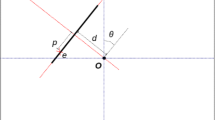Abstract
Range images provide an explicit encoding of the shape and geometric structure of the objects in the image from the point of view of the sensor. Since morphological methods are inherently geometric in nature, they are ideally suited for the analysis of range images. However, morphological edge operators meant for intensity images cannot be used to detect edges in range images because roof and crease edges do not correspond to depth discontinuity. In this paper two schemes for detection and classification of edges in range images based on morphological operations are presented. The first method uses the residues of openings and closings to detect roof and crease edges. Directional sensitivity to edges is incorporated by using structuring elements oriented in different directions. The second method employs the residues of dilation and erosion at multiple scales and provides a richer description of the surface structure at each point in the image by classifying each pixel as belonging to one of the eight possible structure types: positive roof, negative roof, positive crease, negative crease, top of step, base of step, ramp, and constant surface. Several examples, including some involving the fusion of edge information from registered range/intensity images, are presented.
Similar content being viewed by others
References
J. Serra, “Introduction to mathematical morphology,” Comput. Vis. Graph., Image Process, vol. 33, pp. 283–303, 1988.
C. Lanteujoul, “Skeletonization in quantitative metallography”, in Issues of Digital Image Processing, R.M. Haralick and Simon, eds., Sijthoff and Noordhoff: Amsterdam, The Netherlands, 1980.
P.A. Maragos and R. W. Shafer, “Morphological skeleton representation and coding of binary images,” IEEE Trans. Acous. Speech. Signal Process., vol. ASSP 34, pp. 1228–1244, 1986.
P. Maragos, “Tutorial on advances in morphological image processing and analysis,” Opt. Eng., vol. 26, pp. 623–632, 1987.
R.M. Haralick, S.R. Sternberg, and X. Zhuang, “Image analysis using mathematical morphology,” IEEE Trans. Patt. Anal. Mach. Intell., vol. PAMI 9, pp. 532–550, 1987.
P.A. Maragos and R.W. Shafer, “Morphological filters-part II: their relation of median, order statistic and stack filters,” IEEE Trans. Acous. Speech, Signal Process., vol. ASSP 35, pp. 1170–1184, 1987.
B. Jang and R.T. Chin, “Analysis of thinning algorithm using mathematical morphology,” IEEE Trans. Patt. Recog. Mach. Intell., vol. PAMI 12, pp. 541–551, 1990.
A. Mitiche and J.K. Aggarwal, “Detection of edges using range information,” IEEE Trans. Patt. Anal. Mach. Intell., vol. PAMI 5, pp. 174–178, 1983.
W.E. Grimson and T. Pavlidis, “Discontinuity detection for visual surface reconstruction,” Comput. Vis. Graph., Image Process., vol. 30, pp. 316–330, 1985.
M.-H. Chen, D. Lee, and T. Pavlidis, “Residue analysis for feature detection,” IEEE Trans. Patt. Anal. Mach. Intell., vol. PAMI 13, pp. 30–40, 1991.
E. Al-Hujazi and A. Sood, “Range image segmentation with application to robot bin picking using vacuum gripper,” IEEE Trans. Systems, Man, Cybernet., vol. 20, pp. 1313–1324, 1990.
B. Parvin and G. Medioni, “Adaptive multiscale feature extraction from range data,” Comput. Vis. Graph., Image Process., vol. 45, pp. 346–356, 1989.
T.R. Esselman and J.G. Verly, “Some application of mathematical morphology to range imagery,” in Proc. IEEE Int. Conf. on Acoustics, Speech, and Signal Processing, Dallas, April 1987, pp. 245–248.
T.R. Esselman and J.G. Verly, “Feature extraction from range imagery using mathematical morphology,” in T.R. Hsing, ed., Visual Communications and Image Processing II, Proc. Soc. Photo-Opt, Instrum. Eng., vol. 845, pp. 233–240, 1987.
J.S.J. Lee, R.M. Haralick, and L.G. Shapiro, “Morphological edge detection,” IEEE. J. Robotics Automat., vol. RA 3, pp. 142–156, 1987.
R.J. Feehs and G.R. Arce, “Multidimensional morphological edge detection,” in T.R. Hsing, ed., Visual Communication and Image Processing II, Proc. Soc. Photo-Opt. Instrum. Eng. vol. 845, pp. 285–292, 1987.
J. Serra, Image Analysis and Mathematical Morphology, Academic Press: San Diego, CA, 1982, chap. XII.
P. Maragos and R.D. Ziff, “Threshold superposition in morphological image analysis systems,” IEEE Trans. Patt. Anal. Mach. Intell., vol. PAMI 5, pp. 498–504, 1990.
J. Song and E.J. Delp, “The analysis of morphological filters with multiple structuring elements,” Comput. Vis., Graph., Image Process., vol. 50, pp. 283–303, 1990.
R. Krishnapuram and L.F. Chen, “Iterative neural networks for skeletonization and thinning,” in Intelligent Robots and Computer Vision IX, D.P. Casasent, ed., Proc. Soc. Photo-Opt. Instrum. Eng., vol. 1382, pp. 271–281, 1990.
P. Besl and R.C. Jain, “Segmentation through variable order surface fitting,” IEEE Trans. Patt. Anal. Mach. Intell., vol. PAMI 11, pp. 167–192, 1988.
D.H. Ballard and C.M. Brown, Computer Vision, Prentice-Hall: Englewood Cliffs, N.J., 1982.
A.C. Bovik, T.S. Huang, and D.C. Munson, “Effect of median filtering on edge estimation and detection,” IEEE Trans. Patt. Anal. Mach. Intell., vol. PAMI 9, pp. 181–194, 1987.
S. Gupta and R. Krishnapuram, “Morphologic edge detection in range images,” in E.R. Dougherty and P.D. Gader, eds., Proc. Soc. Photo-Opt. Instrum. Eng., Image Algebra and Morphological Image Processing II, vol 1568, pp. 335–346, 1991.
B. Gil, A. Mitiche, and J.K. Aggarwal, “Experiments in combining intensity and range edge maps,” Comput. Vis. Graph., Image Process., vol. 21, pp. 395–411, 1983.
M. Kimmel, R. Jaffe, J. Manderville, and M. Lavin, “MITE: morphic image transform engine, an architecture for reconfigurable pipelines of neighborhood processes,” in Proc. IEEE Computer Soc. Workshop on Pattern Analysis and Image Database Management, Miami Beach, FL, pp. 493–500, 1985.
R.M. Lougheed, “Advanced image processing architectures for machine vision,” in F.J. Corbett, ed., Image Pattern Recognition: Algorithm Implementations, Techniques, and Technology, Proc. Soc. Photo-Opt. Instrum, Eng., vol. 755, pp. 35–51, 1987.
X. Zhuang and R.M. Haralick, “Morphological structuring element decomposition,” Comput. Vis., Graph., Image Process., vol. 35, 1986. pp. 370–382, 1986.
P.D. Gader and S. Takriti, “Decomposition techniques for gray-scale morphological templates,” in Image Algebra and Morphological Image Processing, P.D. Gader, ed., Proc. Soc. Photo-Opt. Instrum. Eng., vol. 1350 pp. 431–442, 1990.
Author information
Authors and Affiliations
Additional information
This research was partially supported by the U.S. Air Force Office of Scientific Research grant 90-0038.
Rights and permissions
About this article
Cite this article
Krishnapuram, R., Gupta, S. Morphological methods for detection and classification of edges in range images. J Math Imaging Vis 2, 351–375 (1992). https://doi.org/10.1007/BF00121878
Issue Date:
DOI: https://doi.org/10.1007/BF00121878




